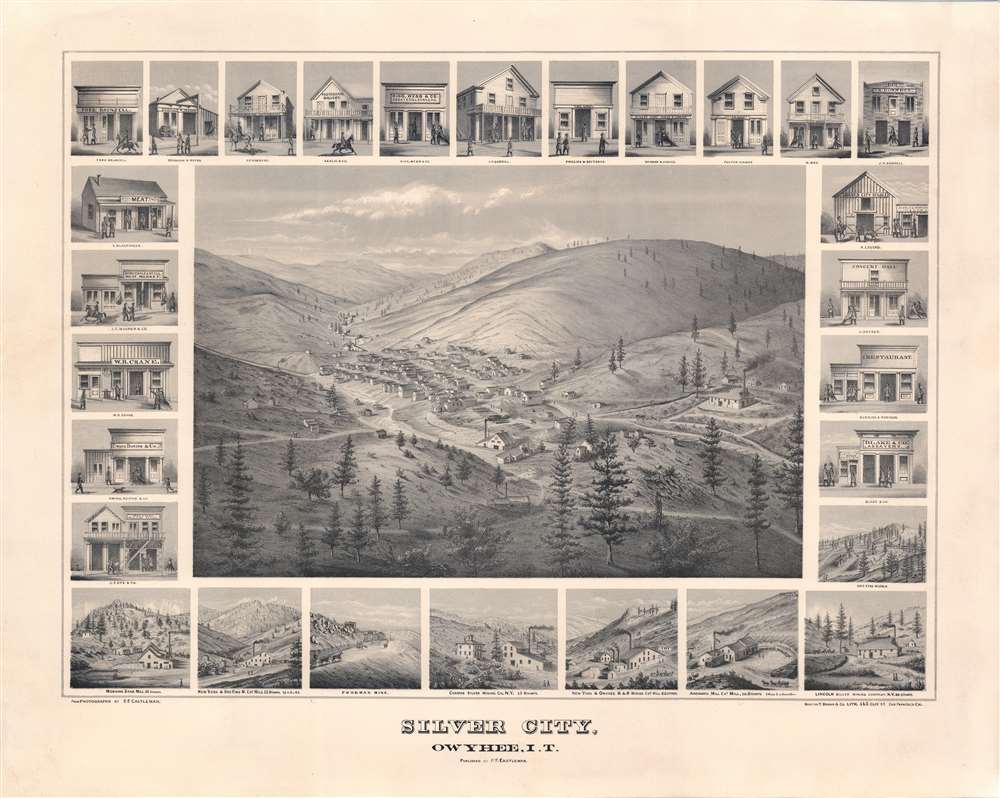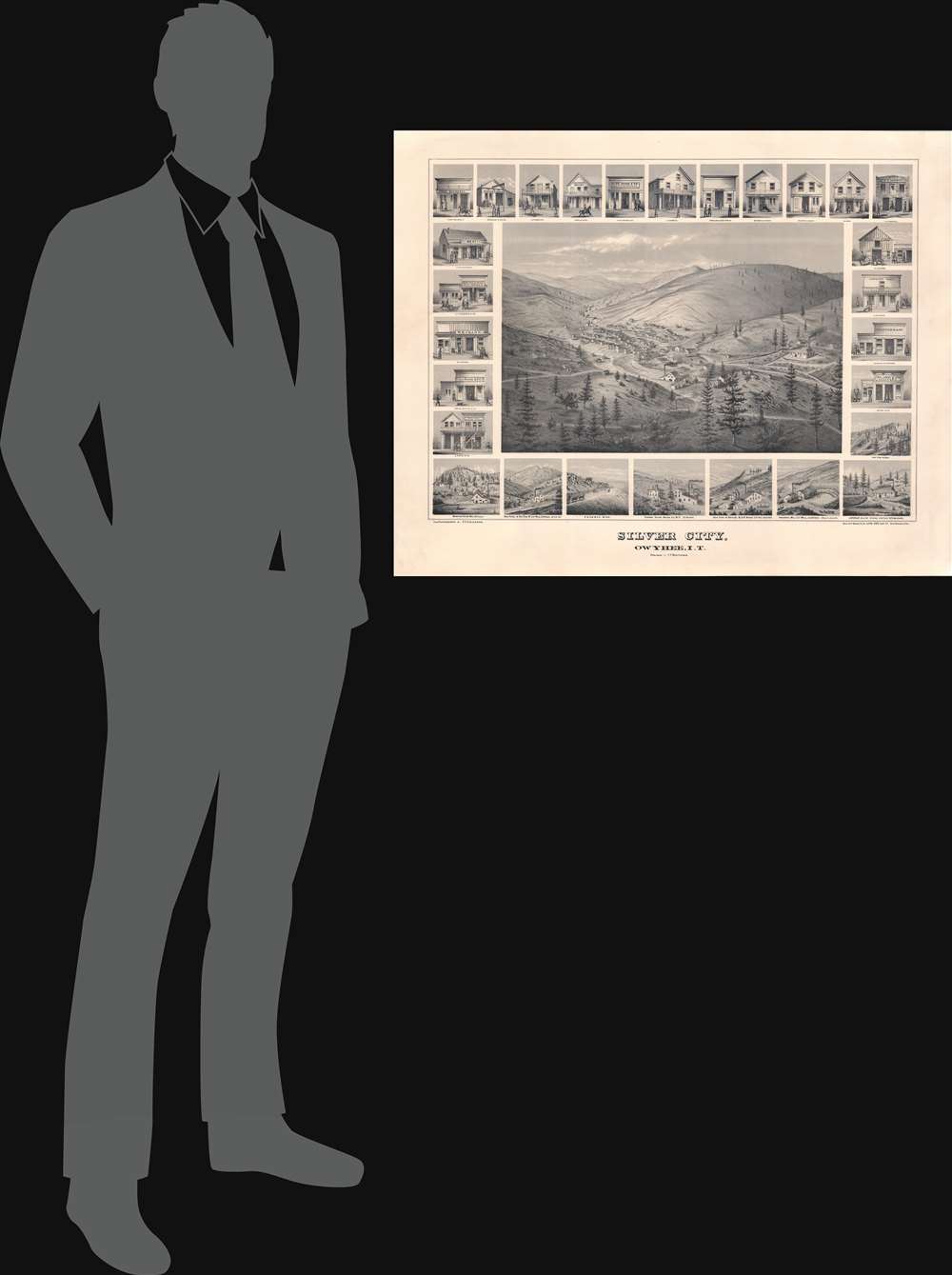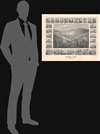This item has been sold, but you can get on the Waitlist to be notified if another example becomes available, or purchase a digital scan.
1866 Grafton Brown Bird's-Eye View Map of Silver City, Ohwyee, Idaho Territory
SilverCity-graftonbrown-1866
Title
1866 (undated) 25.5 x 32.25 in (64.77 x 81.915 cm)
Description
A Closer Look at the Town
The view looks southwards on the town, with Jordan Creek flowing through the center. The town is mostly to the west bank of the creek, with two main streets as well as tracts leading to mines and mills in the background. Most of the buildings in this view would have been constructed in 1865, just as the town was starting to prosper. The famous Idaho Hotel (still in operation), founded in 1863, is likely one of the large buildings at bottom center - where several men are walking into town. The Idaho may be the 'City Hotel' vignette - but it would have been undergoing a major expansion when Castleman visited in 1866.The Vignettes
The view is surrounded by vignettes illustrating the town's most prosperous businesses - no doubt intended to present Silver City as a great place to live and build a business. Those on the bottom illustrate the primary mines: Cosmos, Oro Fino, Morning Star, and the famous Poorman, among others. To the left and right are essential services and 'lifestyle' businesses, including the stables, a concert hall (where weekly dances were held), a restaurant, two meat markets, and the office of a local newspaper, the Silver City Avalanche. At top we recognize a jeweler, a photography gallery (close to Castleman's heart), and various saloons, boarding houses, provisioners, and assayers.Silver City: Boomtown to Ghost town
In the early 1860s, southwest Idaho Territory was as rugged and desolate as anywhere in the American west. The nearby Owyhee Mountains were named after two Hawaiian traders who met their end there in 1819 at the hands a local Snake tribe. Afterwards, the region was rarely visited save by the occasional trapper. In 1863, a 'lucky 29' men led by Michael Jordan worked their way into the Owyhee Valley in search of the legendary Blue Bucket Diggings - a supposed rich gold deposit 'discovered' then 'lost' in 1845. Jordan never discovered the 'Blue Bucket' (nor did anyone else) but he did find gold in the stream that was subsequently named Jordan Creek - here running through the center of the view.Word of the discovery quickly spread and about 500 miners worked their way into the Owyhee Mountains. Several camps were established, but none grew into substantial towns until several spectacular silver quartz lodes were discovered at William Dewey's camp. Dewey's camp was aptly named Silver City. Additional major lodes of both silver and gold, including the Morning Star, Oro Fino, Poorman, Cosmos, and Ainsworth mines were soon discovered. By the time this view was made, in 1866, Silver city has swollen to some 2500 miners, fortune hunters, and businesspeople. It was in this year that Castleman visited Silver City, bringing his camera and recording Silver City at the absolute height of its boomtown prosperity.
The Silver City mines continued to produce spectacularly until about 1869, when silver yields began to decline. This was partly due to depletion of the lodes, partially to poor management, and partially due to the mid-1870s decline in silver value. By 1880, the population declined to about 800. Nonetheless, mining resumed in earnest in the 1880s, by which time silver had partially rebounded and William H. Dewey, founder of Silver City, incorporated several new mining ventures to exploit nearby Florida Mountain.
Dewey's 'Black Jack Lode' and 'Trade Dollar Lode', being particularly rich, drew outside investment from New York and London. The mines and town began to grow again, with multiple new claims appearing, and old claims reevaluated and found to still have rich deposits. Mining continued until about 1910, by which time most claims seemed exhausted. As mining declined, so too did the population. A few prospectors remained, claiming that there was still untold mineral wealth deeper in the mountains, but by the 1940s, there was only one permanent resident, Willie Hawes (1876 - 1968), who was born in town and was its mayor, police chief, fire chief, postman, etc.
Today Silver City is considered a 'ghost town'. Nonetheless, about 70 standing buildings remain - some of which are pictured on this view. Most are still owned by descendants of the original miners and businessmen who built the city. The Idaho Hotel, which was opened in 1863, and is evident on this view, was repaired and reopened in 1972 and still operates seasonally. Silver City itself is listed on the National Register of Historic Places.
A Civically Minded Wild West Town
The town was in some ways a quintessential 19th century mining boomtown, but in other ways unique. Miners came from across the Pacific northwest to work the rich lodes, bringing with them their families and numerous adjacent support businesses. Unlike many historic mining towns, Silver City experienced little frontier lawlessness - except of course claim jumping! - and instead was civically oriented. Local clubs held weekly dances, schools were well funded, and church gatherings were faithfully attended. The mining operations in Silver City relied on stable resident workforce and long-term development to maintain peak production, so even 'greedy' mine operators invested in the town. There was even a Chinatown - separated from the main town by 'Deadman's Alley'. Despite the ominous name, evidence suggests the Chinese population was welcomed and treated equally. African Americans too were active and welcome in the town, some running prosperous businesses, such as 'Silver Walker', the town barber and an avid horse breeder.Publication History and Census
This view was lithographed by Grafton Tyler Brown in San Francisco based upon daguerreotype photographs taken by Philip Frederick Castleman in 1866 - likely the first photographs of Silver City and some of the first photographs of Idaho Territory itself. The view was published by Castleman and Brown in the same year and sold by subscription. Extremely rare, with only one other surviving example at the Idaho State Historical Society.CartographerS
Grafton Tyler Brown (February 1841 – March 2, 1918) was an American painter, lithographer, viewmaker, and cartographer active in California and the Pacific northwest. Brown was one of the few African American lithographers and viewmakers active in the 19th century. He was born in Harrisburg, Pennsylvania and was the son of free blacks involved with the abolitionist movement. He studied printing in Philadelphia from 14 years of age, mastering lithography by the time he reached his maturity. Brown relocated to San Francisco in 1858, when he was just seventeen, and just prior to the outbreak of the American Civil War (1861 - 1865). He initially took work as a steward at the St. George Hotel in Sacramento, but quickly earned a reputation as an excellent artist. Meanwhile in 1850 San Francisco, the viewmakers, Charles C. Kuchel (1820 - 1865) and his artist Emil Dresel, operating as 'Kuchel and Diesel', split ways. Dresel, the artist, moved to Sonoma to open a vineyard. Kuchel needed a new artist and had heard of Grafton Brown through his connections. Grafton accepted the position and moved to San Francisco, where he worked with Kuchel from 1861 to 1865. When Kuchel died in 1865, Grafton purchased the business. Curiously, while he appears in Sacramento directories as 'colored', in San Francisco there is no such designation, later, in Minnesota census records, he is recorded as 'white'. In fact, being very light skinned, he could pass as either race depending on the viewer's expectations. Literature of the period suggests that his true ethnicity was an open secret that most chose to willfully ignore in the face Brown's competence and business acumen. Brown was a lithographer, while most of his San Francisco competitors were letterpress printers. The versatility of lithography gave him a natural advantage in terms of both price and versatility over letterpress. Among his earliest work are advertisements for such prominent firms as Levi Strauss. By 1870 he had a staff of 4, expanding to 8 in 1880. Some of his best customers were mining companies, who issued decorative stock certificates printed by Brown. Through these, he became involved with producing bird's-eye views to promote mining boomtowns. He issued the first and second views of Virginia City, as well as the first and only view of Silver City, Idaho Territory. He also issued a wealth of real-estate maps, primarily focused on Oakland, California. By the 1880s, the silver loads and Oakland real estate business began to decline and, along with it, Brown's business. In 1882, he sold his company and relocated to Victoria, British Columbia, Canada, to work with Amos Bowman in the national Geological Survey. He worked with the survey as a draftsman and landscape artist. Leveraging his history of view making, many of Brown's landscapes were based upon photographs he took. In 1884 he returned to the United States and settled in Portland, Oregon, where he worked as a landscape painter. Brown moved again in 1893, this time to Saint Paul, Minnesota, where he once again worked as a draughtsman, this time for the United States Army Corps of Engineers, as well as for the city of St. Paul. In the 1890s, he worked extensively in Yellowstone, producing photographs, paintings, and views. Brown remained in Minnesota until his death in 1918. More by this mapmaker...
Philip Frederick Castleman (May 17, 1827 - March 24, 1913) was an American daguerreotype photographer active in the late 19th and early 20th centuries. Castleman was born in Hodgenville, Kentucky, where he received a very basic frontier education. At some point, showing promise, he transitioned to teaching and secured a position in Bacon Creek, Kentucky. When gold was discovered at Sutter's Mill, he traveled west with other 49ers - departing on May 3,1849 in a cross-country caravan under the leadership of C. W. Churchill. Of the eighteen men accompanying him, only eleven made it to California. After a few failed attempts at mining at Bidwell's Bar, on the Feather River, Castleman took a position in Sacramento as a baker's assistant. After about half a year, he turned again to mining, working the Redding Diggings, but taking ill, sold his claims. He relocated to Eugene, Oregon in 1851, using his small gold-rush earnings to build a sawmill on Bear Creek, the first such in southern Oregon. Two years later, in 1853, he sold the first mill and in partnership with Milton Lindley built a new mill at Phoenix, on the Rogue River. With some financial security, Castleman decided to return east by ship, crossing the isthmus at Nicaragua. While in New York, he discovered daguerreotyping, with which he became enamored. Toting a full daguerreotyping and developing setup, Castleman returned to the west coast, this time via Panama. He was one of the first two photographers on the west coast, pioneering the art in Northern California and Southern Oregon. Around this time, he fought and was wounded in the Indian Wars along the Rogue River. He was sent to Eugene to recover from this war wounds. In 1855, after the Indian War, he sold his mill interests and began running pack-trains from the Willamette Valley to mining camps in southern Oregon. By 1857, he established livery stables in Oregon, and later in Walla Walla. Between 1862 and 1867, Castleman alternated between running supply caravans to mines in Oregon and Idaho Territory and doing professional photography 'of all kinds'. Often, Castleman carried his photographic equipment with him while on supply missions, recording some of the most important and ephemeral mining booms in American history. During this time, he developed a lucrative partnership with the African American San Francisco lithographer Grafton T. Brown (1841 - 1918), wherein Brown would create lithographic city views from Castleman's photographs. The views are among the earliest and most important views of important mining sites and boomtowns in the Pacific Northwest. Some of these views include Silver City, Walla Walla, Boise, and Portland, among others. He relocated to Portland in 1878, where remained until 1908, when he moved to Berkeley, California. He died in San Francisco in 1913. Learn More...




